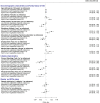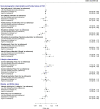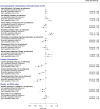Factors associated with frequency of fruit and vegetable consumption among selected sub-Saharan African populations: evidence from the Cardiovascular H3Africa Innovation Resource Project
- PMID: 38199785
- PMCID: PMC10859155
- DOI: 10.1093/ije/dyad171
Factors associated with frequency of fruit and vegetable consumption among selected sub-Saharan African populations: evidence from the Cardiovascular H3Africa Innovation Resource Project
Abstract
Background: Frequent fruit and vegetable consumption is considered a promising dietary behaviour that protects health. However, most existing studies about the factors associated with this phenomenon among Africans are based on single-country reports, apart from one meta-regression combining smaller studies. This study harmonized large datasets and assessed factors associated with the frequency of fruit and vegetable consumption in this population.
Methods: Individual-level data on sociodemographics, lifestyle and diet from 20 443 participants across five African countries (Burkina Faso, Ghana, Kenya, South Africa and Nigeria), from the Stroke Investigative Research and Educational Network (SIREN) and Africa Wits-INDEPTH partnership for Genomic Research (AWI-Gen) studies, were harmonized. Total frequency of fruit and vegetable consumption (in portions/week) was classified as 'low' (≤6), 'moderate' (7-14) and 'high' (≥15). Adjusted odds ratios (aORs) and 95% confidence intervals (CIs) of factors associated with the total frequency of fruit and vegetable consumption (using 'low' consumption as the reference) were estimated using multinomial regression models.
Results: Mean age of participants was 54.3 ± 11.8 years, 10 641 (52.1%) were female, and the median (interquartile range) frequency of total fruit and vegetable consumption was 10.0 (4.0, 21.0) portions/week. Participants with a family history of cardiovascular disease [moderate (aOR, 0.92; 95% CI, 0.85, 1.00) and high (aOR, 0.85; 95% CI, 0.78, 0.92)], current smokers [moderate (aOR, 0.83; 95% CI, 0.74, 0.94) and high (aOR, 0.78; 95% CI, 0.69, 0.88)], current alcohol users [moderate (aOR, 0.92; 95% CI, 0.85, 1.00) and high (aOR, 0.82; 95% CI, 0.76, 0.89)] and physically inactive participants [moderate (aOR, 0.85; 95% CI, 0.75, 0.96) and high (aOR, 0.80; 95% CI, 0.70, 0.90)] were less likely to consume fruits and vegetables frequently.
Conclusion: Africans with lifestyle risk factors for cardiovascular disease were less likely to consume fruit and vegetables frequently.
Keywords: Africans; Fruits; behaviour; diet; food frequency; lifestyle; vegetables.
© The Author(s) 2024; all rights reserved. Published by Oxford University Press on behalf of the International Epidemiological Association.
Conflict of interest statement
None declared.
Figures



References
-
- Stanaway JD, Afshin A, Gakidou E. et al. Global, regional, and national comparative risk assessment of 84 behavioural, environmental and occupational, and metabolic risks or clusters of risks for 195 countries and territories, 1990–2017: a systematic analysis for the Global Burden of Disease Study 2017. Lancet 2018;392:1923–94. - PMC - PubMed
-
- World Health Organization; Nutrition Unit. Fruit and Vegetable Promotion Initiative: A Meeting Report, 25–27/08/03. Geneva: World Health Organization, 2003.
MeSH terms
Grants and funding
LinkOut - more resources
Full Text Sources

